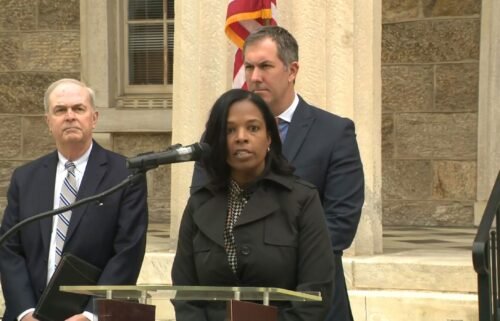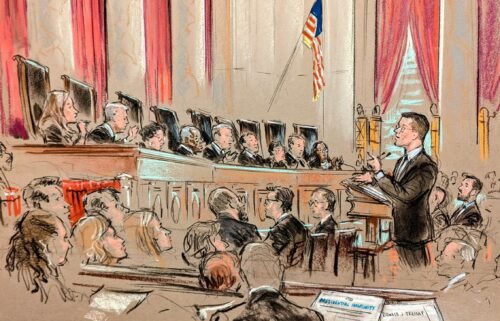Why Latinos in California are being hit hard by Covid-19

Every step for Jenny Ruelas is a challenge.
The 31-year-old has to pause to catch her breath, carries a can of oxygen with her wherever she goes, and walks with a cane — all of this since she contracted Covid-19 in May.
Her doctors told her that one side of her heart is now larger than the other, she says, but her heart is also broken after losing her father to the virus. His girlfriend also died, leaving their five young children without parents.
“I have no balance in my body,” Ruelas told CNN. “It’s hard for me to breathe, I can’t walk for too long without running out of breath. I have to constantly check my oxygen — something I would never even think of before. It sometimes drops so low, I feel like I’m breathing through a straw. Now I even have trouble sleeping. That was never an issue before. I just can’t do anything without help.”
Ruelas’ experience mirrors that of many other Latinos across the US, who have been disproportionately affected by coronavirus.
According to Johns Hopkins University, racial and ethnic information is only available for about 35% of all deaths in the United States, but even in that small percentage it is evident that Latinx Americans are unevenly impacted by the coronavirus in some regions. In fact, across the West, Latinos are bearing the brunt of the pandemic.
People who identify as Latinx are four times more likely to be hospitalized than White people, according to data released by the Centers for Disease Control and Prevention. Experts have said the Hispanic community has been disproportionately hurt by the coronavirus pandemic due to their jobs as essential workers and multigenerational living conditions.
In California, Latinos represent 60% of Covid cases and nearly 50% of deaths through August, according to the state’s department of public health, despite the fact that Latinos make up less than 40% of California’s population.
Los Angeles County, where Ruelas lives, has the highest number of cases and deaths. Again, the majority are Latinos.
Latinos are ‘significant portion’ of essential workforce
In every county in the state, Latinos are the most severely impacted by the virus, said Dr. Gil Chavez, an epidemiologist and co-chair of California’s Covid-19 testing task force — a position that pulled him back to work two months into his retirement.
“Latinos have some of the known factors for having really increased cases and having more bad cases than other members of the population,” Dr. Chavez told CNN. “We have very high rates of diabetes, hypertension, heart disease and some of the immunocompromised conditions (like) obesity (and) smoking.”
These trends highlight historical issues for Latinos, not just in California but nationwide, such as social disparities in terms of financial opportunities, health care access and utilization.
In late July, the Kaiser Family Foundation released research that warned growing Covid-19 hotspots in the South and West at the time would likely widen disparities for people of color.
“The shifting surge in outbreaks to the South and West will likely exacerbate the disparate effects of COVID-19 for people of color,” KFF wrote in its report. “Hispanic people may be particularly hard hit as outbreaks rise in these areas.”
Many of the jobs Latinos have in California don’t allow for flexible schedules or for the work to be done from home, Dr. Chavez said, which also contributes to the high contraction rates.
“Latinos make really a very significant portion of what we would call the essential workforce,” Dr. Chavez said. “Latinos are heavily represented in many industries that provide vital services from growing food, to producing food, to working as support staff in hospitals/healthcare facilities, driving trucks and cars. Many of those occupations really put people in increased risk of exposure for Covid-19.”
This is most clearly evident in the agriculturally rich Central Valley of the state where at one point this summer, the positivity rate in the region soared to about 18%, prompting California Gov. Gavin Newsom to send in three support teams to provide clear messaging in English and Spanish.
Newsom said he sent the teams to eight of the hardest hit counties in the region — San Joaquin, Stanislaus, Merced, Madera, Fresno, Kings and Tulare, and Kern counties.
“There are certain parts of the state, certain regions, and certain sectors that are disproportionately impacted by the transmission of this virus,” the governor said in a July press conference.
The support teams are boosting testing and contact tracing efforts in alliance with social services support. That includes food and shelter for people who can’t go to work because they need to quarantine or isolate while sick with the virus or after exposure to someone who did test positive.
The positivity rate has since dropped in the region, but is still about double that of the statewide positivity rate which is currently around 6%, according to state data.
The California Farmworker Foundation is also now offering free testing at work sites making it more likely that hourly workers will participate.
Dr. Chavez said a lack of trust in authorities may also be a hindrance to the fight to control the virus in certain communities.
“People may not be going out to get tested,” he said. “People may not take care of their sickness so when they go get care, they may actually have waited too long.”
Underlying health issues, coupled with Latinos’ higher exposure to the virus, often make for a more intense battle with the illness — meaning the possibility of a more severe case.
How Covid quickly spread in one household
Ruelas lived with her 60-year-old father Humberto Ruelas, his 38-year-old girlfriend Karina Bonilla, and their five children, ages two to 17, in South Los Angeles.
Bonilla was the first to get sick. “She used to work for a fruit vendor and her boss … he was positive with Covid,” Ruelas said.
Within a couple of days, Ruelas said, Humberto was also sick.
“He did go to the hospital three times. The first one, he was negative for Covid but he did have pneumonia. Then the second time, that’s when he found out he was positive for Covid. And the third time, that was his final stay. He didn’t come back.”
At this point, Ruelas, who worked with adults with developmental disabilities, was still going to her job so she wasn’t at home as much. When her schedule shifted, she ended up spending more time with her family.
“I got sick right away but the thing about me is that I didn’t know about my dad’s girlfriend and her boss having Covid,” she said.
Ruelas said she was unable to breath, walk or even “make it to the bathroom.” Over-the-counter medication wasn’t working, and she kept feeling chest pain.
Meanwhile, Humberto was also in bad shape. “He couldn’t really talk. He couldn’t move much,” Ruelas said.
But it never crossed Ruelas’ mind that she could have the coronavirus, because she took all the necessary precautions.
“When I came back from work, I would disinfect myself, change my clothes — constantly washing my hands, always wore a mask,” she said. “I didn’t even go into stores and I had my food delivered. So, I knew it couldn’t be me.”
One day, one of her younger brothers came to her room and she told him that she felt like she was dying.
“And he looks at me and he’s like, ‘You probably have Covid like my mom,'” Ruelas said. “I felt the whole world just kind of fell on me.”
She immediately called her boss to inform him that someone in her home had tested positive for the virus and that she would not come back to work until she got tested. Her sister confirmed with their father that Bonilla had Covid.
Ruelas drove herself to the hospital and was immediately admitted. She tested positive for Covid-19 and was placed in an isolation room. Within days of Jenny, her dad and Bonilla were admitted together to the same hospital.
“I only remember maybe four days out of the 11 days that I was there,” she said, noting it was after she was moved out of the emergency room when she spoke to her father again.
“He couldn’t say much. Our conversation was like 26 seconds,” Ruelas said. “He just said, ‘I just need you to be okay.'”
But it was difficult for Ruelas to talk. “It was hard to have any reaction without my oxygen dropping, without me feeling like my heart was gonna come out my chest. It was even hard to cry.”
Nurses were having a hard time controlling Ruelas’ temperature, so they surrounded her with ice packs.
“I started getting weird rashes around my body and I had a fever. I had a headache. I did have weakness. For two days, I couldn’t walk or move. It would burn to open my eyes,” Ruelas said. “Definitely chest pain all the time and pain in my back, which was my lungs. I did have loss of taste and smell. I definitely couldn’t eat. I would vomit.”
As she fought the virus herself, Ruelas was getting indications from doctors that her father, who was in the room right next to hers, wasn’t doing well.
“I felt him close even though he couldn’t talk to me right away. I said there’s only a wall dividing us. I can talk to him,” Ruelas said.
The next day, her sister arranged a video chat for Ruelas to see their dad. But it was hard for her to see their father, face down and on a ventilator, not responding.
The doctors weren’t giving their father more than 24 hours to live.
Ruelas could barely move but she realized while she was in the bathroom, she could hear the nurses and doctors in her father’s room. That meant they could hear her — her father might hear her.
“I hit the wall. I was like, ‘Dad, don’t do this to me. Don’t,” Ruelas said through tears.
The medical workers had tried to let her see her dad one last time before he died, but she and her sister didn’t make it in time. Within minutes, her father was gone.
“Even though he had passed already, his facial expressions — you can see the pain,” she said, sobbing. “He was in a lot of pain and that’s the face I won’t ever forget.”
Within eight hours of Humberto’s death, his girlfriend also died — the same day that Ruelas was discharged from the hospital.
A long recovery
Ruelas no longer tests positive for the virus, but she definitely hasn’t recovered. While she was in the hospital, she said she had a stroke. Besides all of her other health problems, she also now has trouble remembering things.
Besides the three family members who contracted the coronavirus, Ruelas’ 12-year old sister also tested positive but was asymptomatic. She has also since recovered.
Now Ruelas lives in the house alone — the house that used to be vibrant and full of voices — and her younger siblings, having lost both of their parents, are now staying with Ruelas’ older sister.
“You know the things you thought once were annoying? Why can’t we just have peace and quiet?” Ruelas said. “Like now that I have peace and quiet, I miss that.”
She also misses her father, who she described as loud and funny.
“It’s not easy waking up and not hearing a thing, not hearing him because one thing about my Dad, when he got to the house, everybody knew he was home,” Ruelas said, admitting she struggles with his absence as she passes his room. “I have to do a reality check. He’s not going to come out of there anymore. Out of respect, the doors are still closed. Everything is still there.”
She said she was once in the shoes of those who didn’t believe the virus could hit as hard as it did. But now she knows otherwise.
“You haven’t been in the hospital,” she said. “You haven’t heard everything I’ve heard. You haven’t experienced the pain. It’s painful having severe Covid. It’s really painful and it can happen to anyone. Today it was me. Tomorrow, it can be absolutely anyone.”



